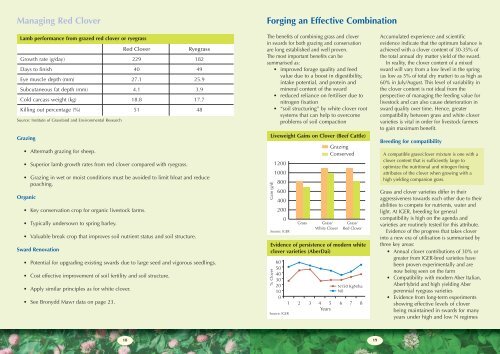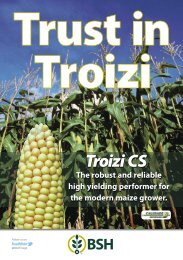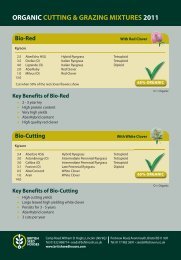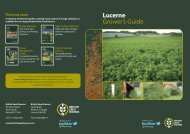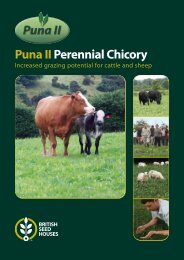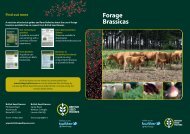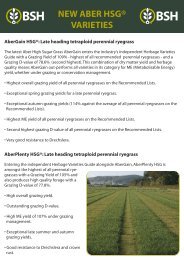You also want an ePaper? Increase the reach of your titles
YUMPU automatically turns print PDFs into web optimized ePapers that Google loves.
Managing Red <strong>Clover</strong><br />
Forging an Effective Combination<br />
Lamb performance from grazed red clover or ryegrass<br />
Red <strong>Clover</strong><br />
Grazing<br />
• Aftermath grazing for sheep.<br />
• Superior lamb growth rates from red clover compared with ryegrass.<br />
• Grazing in wet or moist conditions must be avoided to limit bloat and reduce<br />
poaching.<br />
Organic<br />
• Key conservation crop for organic livestock farms.<br />
• Typically undersown to spring barley.<br />
• Valuable break crop that improves soil nutrient status and soil structure.<br />
Sward Renovation<br />
• Potential for upgrading existing swards due to large seed and vigorous seedlings.<br />
• Cost effective improvement of soil fertility and soil structure.<br />
• Apply similar principles as for white clover.<br />
• See Bronydd Mawr data on page 23.<br />
Ryegrass<br />
Growth rate (g/day) 229 182<br />
Days to finish 40 49<br />
Eye muscle depth (mm) 27.1 25.9<br />
Subcutaneous fat depth (mm) 4.1 3.9<br />
Cold carcass weight (kg) 18.8 17.7<br />
Killing out percentage (%) 51 48<br />
Source: Institute of Grassland and Environmental Research<br />
The benefits of combining grass and clover<br />
in swards for both grazing and conservation<br />
are long established and well proven.<br />
The most important benefits can be<br />
summarised as:<br />
• improved forage quality and feed<br />
value due to a boost in digestibility,<br />
intake potential, and protein and<br />
mineral content of the sward<br />
• reduced reliance on fertiliser due to<br />
nitrogen fixation<br />
• “soil structuring” by white clover root<br />
systems that can help to overcome<br />
problems of soil compaction<br />
Liveweight Gains on <strong>Clover</strong> (Beef Cattle)<br />
% <strong>Clover</strong> Gain (g/d)<br />
1200<br />
1000<br />
800<br />
600<br />
400<br />
200<br />
0<br />
Source: IGER<br />
60<br />
50<br />
40<br />
30<br />
20<br />
10<br />
0<br />
Grazing<br />
Conserved<br />
Grass Grass/ Grass/<br />
<strong>White</strong> <strong>Clover</strong> Red <strong>Clover</strong><br />
Evidence of persistence of modern white<br />
clover varieties (<strong>Aber</strong>Dai)<br />
•<br />
•<br />
•<br />
•<br />
• •<br />
•<br />
•<br />
• • • •<br />
•<br />
•<br />
N150 KgN/ha<br />
N0<br />
1 2 3 4 5 6 7 8<br />
Years<br />
Source: IGER<br />
Accumulated experience and scientific<br />
evidence indicate that the optimum balance is<br />
achieved with a clover content of 30-35% of<br />
the total annual dry matter yield of the sward.<br />
In reality, the clover content of a mixed<br />
sward will vary from a low level in the spring<br />
(as low as 5% of total dry matter) to as high as<br />
60% in July/August. This level of variability in<br />
the clover content is not ideal from the<br />
perspective of managing the feeding value for<br />
livestock and can also cause deterioration in<br />
sward quality over time. Hence, greater<br />
compatibility between grass and white clover<br />
varieties is vital in order for livestock farmers<br />
to gain maximum benefit.<br />
Breeding for compatibility<br />
A compatible grass/clover mixture is one with a<br />
clover content that is sufficiently large to<br />
optimize the nutritional and nitrogen fixing<br />
attributes of the clover when growing with a<br />
high yielding companion grass.<br />
Grass and clover varieties differ in their<br />
aggressiveness towards each other due to their<br />
abilities to compete for nutrients, water and<br />
light. At IGER, breeding for general<br />
compatibility is high on the agenda and<br />
varieties are routinely tested for this attribute.<br />
Evidence of the progress that takes clover<br />
into a new era of utilisation is summarised by<br />
three key areas:<br />
• Annual clover contributions of 30% or<br />
greater from IGER-bred varieties have<br />
been proven experimentally and are<br />
now being seen on the farm<br />
• Compatibility with modern <strong>Aber</strong> Italian,<br />
<strong>Aber</strong>Hybrid and high yielding <strong>Aber</strong><br />
perennial ryegrass varieties<br />
• Evidence from long-term experiments<br />
showing effective levels of clover<br />
being maintained in swards for many<br />
years under high and low N regimes<br />
18<br />
19


